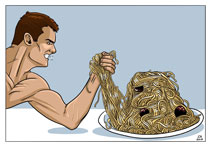How to Manage a Mess

Managing is difficult at best.
For new managers, it’s even worse.
But inheriting a mess or dysfunctional team can try the experience, expertise, and skills of even the most seasoned managers. Trying to undo the mistakes and shortcomings of an incompetent predecessor can be like trying to arm wrestle a plate of spaghetti. There may be “obvious” items such as redundant processes, unnecessary paperwork, or poor equipment or software choices. But there may also be not so obvious items such as the person who wanted your job and is out for revenge. Or how about the person who, in reality, was running the department while your predecessor slept. Then of course, our favorites - the difficult employees. You know them, the passive aggressive, the victim, the disrupter, the martyr, or the inconsistent employee. Fortunately, those who have gone before have left a blueprint to help guide managers, at almost any, level toward success in managing a mess.
- In the Beginning – Self-preservation comes first. Heather Huhman offers some excellent suggestions.
- Know and live the company’s vision, mission, and core values
- Have in-depth knowledge of your own boss’s expectations of you and your team
- Network and build professional relationships internally and externally
- Learn everything you can about your internal and external customers
- Understand the organization’s culture
- The First Meeting – Yes, you need to have a meeting with your team. Do not delay this all-important meeting. It needs to be held right away. At this meeting do NOT brag about your accomplishments (they won’t care), do not tell them what your plans are (they’ve heard it before) and do not tell them “how it’s going to be” going forward (they could care less about your commando dictates).
- Language - Be sure your language always includes “we” and “us” – not “they” and “them.” You are a team now and you cannot distance yourself from the very ones you will charge in carrying out tasks to meet goals.
- Communicate and Brainstorm – Ask people about their honest assessment of the current situation and ideas on how to move forward. There will be many ideas people bring to the group to discuss, tweak, dismiss, or move forward to help reach goals. If some items are too sensitive, they may have to be introduced as more trust is gained.
- Assessment – Use assessments to evaluate team members and examine roles and responsibilities. When your team understands that you have their own career objectives in mind as well as those of the organization, you will begin the long journey of building trust and respect. Taking the time to gain the knowledge of your team’s skills and attributes, how they can best use them in their jobs and on special assignments is teambuilding at its best.
- The Plan, The Plan – A 30/60/90-day plan helps guide and keep you and your team on track.
- Check In – Meeting with your team members individually every two weeks is a tool that will keep you abreast of what’s going on in your department, avoid unpleasant surprises, and keep your team members on track. Team members will feel that they have been heard and that you value them and their input.
- The Difficult Employee – Safari offers some unique ideas on how to get things off on the right foot with an employee whose being difficult.
- Set up a one-one-meeting.
- Take the meeting outside your office, or better yet off property
- You go to the employee’s desk and pick them up
- Ask questions. Listen! Don’t interrupt.
- Give Credit – Take the Blame – Demonstrating – in public – to an employee that you have their back is priceless. Praise in public and discipline in private. It’s one thing to tell your team that you “have their back” or that you are “on their side.” Standing up for and praising people in public will bring loyalty no one can buy.
Speaking of blame. Don’t be a meat ball, (sorry, couldn’t resist). Do not bad mouth or blame your predecessor. This will not win you any votes. In addition, they don’t care how you used to do it at your former company. If that company was so great, why did you leave? Keep references to them and your victories under wraps. Your aim is not to come off as shallow as an old spaghetti western.
- Coaching – Coaching is an effective tool to help you and the members of your team to meet their, yours, and the organization’s goals. If you are not confident about your coaching skills, there are plenty of outside coaches to bring on board. Your organization may have an internal coach as well. Sometimes it can be tricky for the manager to be the coach. That is something you will need to analyze and then decide on the best choice.
Take time to understand your team’s history. You will gain insights that help you know the team in terms of …
- What they have accomplished
- The obstacles they have overcome,
- Stories that teams have are important to understand what the team values
- Understanding what the team values can tell you a lot about this team’s and the organization’s culture
- You will gain an understanding of what has and has not worked with this team in the past
- You will learn from their failures
- You will understand the contributions this team has made to the organization
- Team members will respect you for taking the time to know their history
Animals go in and mark their territory immediately. This is not good management or leadership. As we all know, change is not easy and is like trying to eat a plate of spaghetti without the help of the rolling action and a spoon. Trying to make sweeping changes is like trying to arm wrestle a plate of spaghetti. Begin right away, but there are many actions, processes, and procedures that deserve your strong consideration. Bon Appetit!
of the rolling action and a spoon. Trying to make sweeping changes is like trying to arm wrestle a plate of spaghetti. Begin right away, but there are many actions, processes, and procedures that deserve your strong consideration. Bon Appetit!
Thank you for eating, er, um, I mean reading this blog. If you would like to discuss how to help your first-time managers, call 404-320-7834, or email This email address is being protected from spambots. You need JavaScript enabled to view it., or visit www.performstrat.com
Arm Wrestle Graphic Credit: supersienar
Eating Spaghetti Graphic BigStock.com Copyright: MalkovKosta